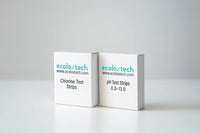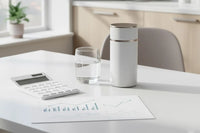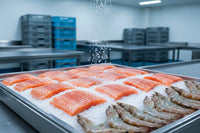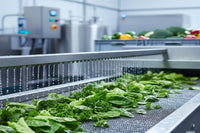Food processing facilities live and die by their sanitation practices. The right disinfectants prevent contamination, protect consumers, and keep you compliant with safety regulations. Each year, millions get sick from foodborne illnesses that robust sanitation could have prevented. In an industry where a single outbreak or recall can tarnish a brand, effective disinfection isn’t just important – it’s non-negotiable. But are the chemicals you’ve relied on for years truly the best we can do?
Why Disinfectants Matter in Food Processing
When hygiene is paramount, every surface, utensil, and drop of water in a food plant needs to be free of harmful microbes. Bacteria like Listeria, Salmonella, and E. coli lurk as invisible threats that can hitchhike on equipment or ingredients and end up in finished products. Strong sanitizers and disinfectants are the frontline defense against these pathogens, ensuring that food is safe from production to packaging. By killing 99.999% of microbes on food-contact surfaces, sanitizers dramatically reduce the risk of contamination. In short, without reliable disinfectants, consistent food safety would be impossible. This is why the FDA and other agencies set strict standards – a sanitizer must achieve a 5-log reduction (99.999% kill) on food-contact surfaces. Food processors dutifully incorporate daily cleaning and sanitizing cycles to meet these standards and protect public health.
However, not all disinfectants are created equal. Different facilities use different chemicals – from tried-and-true chlorine bleach to newer alternatives – each with their own pros and cons. Below we’ll explore the most common sanitizers used in food processing, acknowledging what they do well while shining a light on their often-overlooked limitations.
Common Sanitizers in the Food Industry – and Their Limitations
- Chlorine Bleach (Sodium Hypochlorite) – Widely used due to its availability, low cost, and broad-spectrum kill power. However, bleach is highly corrosive to metals and equipment, irritates skin and lungs, and gives off harsh fumes. It loses potency quickly in the presence of organic matter or if not used at the proper pH, and may require thorough rinsing to avoid residues.
- Chlorine Dioxide (ClO₂) – A powerful oxidizing biocide that’s 3–4 times as potent as bleach and less corrosive. It’s effective across a wide pH range and penetrates biofilms, but it must be generated on-site using reactive precursors and specialized equipment, making it costly and complex.
- Ozone (O₃) – A strong oxidizer that leaves no residue and kills a wide range of microbes. However, it’s hazardous to humans at high levels, requires on-site generators, and must be carefully controlled to avoid food quality issues.
- Quaternary Ammonium Compounds (Quats) – Popular for their non-corrosive and odorless properties, and they can leave residual antimicrobial activity. But residues may contaminate food, reduce effectiveness in hard water, and raise environmental and health concerns with repeated exposure.
- Peracetic Acid (PAA) – Effective against a broad spectrum of microbes and breaks down into harmless by-products, making it organic-approved. However, it’s corrosive, has a strong odor, and can irritate skin and lungs. It also tends to be more expensive than chlorine sanitizers.
Each of these conventional sanitizers has benefits – and serious drawbacks. They “get the job done” but often at the expense of worker safety, equipment longevity, or operational efficiency. Food processors have largely accepted these pain points as the price of sanitation. But should we?
Are Your Current Sanitizers Holding You Back?
If you’ve been in the industry for a while, you might have a nagging feeling that traditional chemicals come with hidden costs. Ask yourself:
- Corrosion & Damage: Has expensive equipment started to rust or degrade due to corrosive chemicals like chlorine bleach?
- Safety Concerns: Do your employees need heavy PPE just to do routine sanitizing?
- Extra Rinsing & Labor: Are you doing extra rinses to remove chemical residues?
- Impact on Product Quality: Have you worried about sanitizer residues or odors affecting your food’s taste or shelf life?
If these questions make you uneasy, you’re not alone. Many food processors assume there’s no equally effective alternative. But what if there is a better way?
Meet Hypochlorous Acid (HOCl) – A Safer, More Effective Alternative
After years of relying on harsh chemicals, the food industry is buzzing about hypochlorous acid (HOCl). Despite the name, it’s a gentle yet powerful disinfectant – the same substance your white blood cells produce to fight pathogens. HOCl is generated on-site by electrolyzing a simple saltwater solution, producing a non-toxic, food-safe sanitizer that kills 99.99% of microbes within seconds.
HOCl is 80–100 times more effective than bleach yet non-irritating and residue-free. It’s EPA-registered, FDA-cleared, and USDA-approved for direct food contact and no-rinse sanitizing.
Let’s look at why it’s transforming food processing sanitation:
- On-Site Generation: Produced from salt, water, and electricity using electrolysis generators like EcoloxTech systems – eliminating storage, transport, and mixing of hazardous chemicals.
- No-Rinse Sanitizer: Breaks down into saline after use – no residues, no extra rinse steps, saving time and water.
- Non-Toxic and Worker Safe: Gentle enough for skin contact, no fumes or irritation. Improves safety and morale during cleaning shifts.
- Powerful Efficacy: Kills E. coli, Listeria, Salmonella, norovirus, and more within seconds. Extends product shelf life when used as a produce wash or mist.
- Regulatory Compliance: EPA, FDA, USDA, and NSF approved for food equipment and direct contact applications. Fully HACCP and GMP compatible.
- Cost & Labor Savings: Produces sanitizer for as little as $0.10 per gallon. Saves on procurement, water, and labor – while reducing risk and chemical waste.
In summary, HOCl solves the very problems other disinfectants create – offering powerful microbial control without corrosion, toxicity, or complexity. It’s a genuine leap forward for food processors ready to modernize their sanitation programs.
Ready to Embrace a Safer Sanitization Solution?
If you’re rethinking your disinfection process, you’re not alone. Hypochlorous acid offers a safer, more efficient path forward. Schedule a free sanitation audit with our food safety experts to see how HOCl can save time, money, and effort in your operation.
Check out HOCl generation systems like the EcoloxTech E300 and E1200 – producing up to 1,200 liters per hour of hospital-grade HOCl for food applications. Imagine eliminating Listeria or Salmonella on contact without exposing staff to harsh fumes or damaging equipment – that’s what HOCl makes possible.
Don’t let outdated sanitizers hold your facility back. A safer, more effective alternative is here. Protect your products, people, and profits with the power of HOCl. Your next big leap in hygiene could be as simple as salt, water, and a little electricity.





